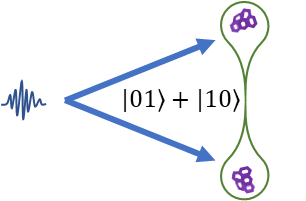One of the aims of fundamental physics is to obtain a theory that can combine gravity with quantum physics. As I mentioned before, theory space is vast. A successful venture into theory space needs a reliable guiding principle. Without any experimental result pointing out the direction we need to take, the selection of such a guiding principle for the formulation of a quantum theory of gravity is difficult.
Some people believe that quantum gravity is the domain of the Planck scale where quantum and gravitational effects coincide. It requires extremely high (experimentally unattainable) energy densities. It also assumes that such high energy densities allow things like black holes and worm holes to pop in and out of existence. That is however an unscientific notion. Things don’t just pop in and out of existence, least of them black holes, regardless of the energy density.
Moreover, there are no such things as worm holes. I don’t care that Einstein thought they may exist. The idea represents one of those cases where the mathematics is over extended to produce a spurious solution that, although allowed mathematically, has no physical meaning. So they cannot pop in and out of existence anyway.
Hence, it is unlikely that there is anything interesting happening at the energy scale represented by the Planck scale, or more accurately called the hypothetical Planck scale. Therefore, I would not recommend any statements about what happens at this hypothetical Planck scale as a reliable guiding principle for quantum gravity.
As a more reliable guiding principle, we need to address the question, what happens to the gravitational field produced by a quantum state? What I mean by a quantum state is a state of matter in which quantum effects are manifest. An example of such a quantum effect is entanglement. So the question in this case is, does the gravitation field become entangled with the quantum state, or is the gravitational field uniquely produced by some combination of the elements in the superposition that represents the entangled state?

We can address the question with our current theory of general relativity. In Einstein’s field equation for general relativity, the curvature tensor of spacetime is equated to the stress-energy tensor of the matter distribution. In the context of quantum theory, the latter becomes an observable – an operator that can be traced with the quantum state to produce the observed stress-energy tensor of the quantum state. Obviously, the observed stress-energy tensor does not represent the entanglement anymore. Therefore, the curvature of spacetime produced by such an entangled state is affected by a combination of the elements in the superposition and does not become entangled with the state.
What does this say about the guiding principle for quantum gravity? What it seems to say is that there is no need for quantum gravity. The spacetime that we live in is a background in which the intricacies of quantum physics play out without becoming involved. The only effect that the quantum state of matter has on the gravitational field is through a unique stress-energy distribution for the entire state.
This conclusion is based on the assumption that Einstein’s field equation is valid on the small scale of quantum physics. It has been tested at larger scale and so far no deviations have been found. Without any observed deviations, there is not strong motivation for expecting that it would not be valid at the scales of quantum physics.
However, there is one aspect that Einstein’s field equation does not explain. It shows the connection between the curvature of spacetime and the distribution of matter, but it does not explain how mass-energy curves spacetime. It does not give a mechanism for this process. Such a mechanism may be hiding in the quantum description of matter. If such a mechanism can be uncovered, it would lead to a more comprehensive theory that would “explain” the Einstein’s field equation.
The search for this mechanism may be somewhat different from a search for a theory of quantum gravity. However, it can be seen as a more focussed attempt at formulating a theory of quantum gravity. To find this mechanism, we can perhaps focus of fermions. I think there are still some mysteries associated with fermions that need to be uncovered. Perhaps that can lead us to an understand of the mechanism for the way that mass-energy curves spacetime.
